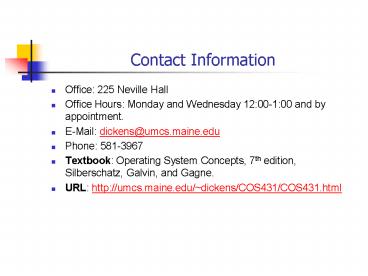Contact Information - PowerPoint PPT Presentation
1 / 22
Title:
Contact Information
Description:
Textbook: Operating System Concepts, 7th edition, Silberschatz, Galvin, and Gagne. ... System Components. Components of a Computer System. Operating System: ... – PowerPoint PPT presentation
Number of Views:23
Avg rating:3.0/5.0
Title: Contact Information
1
Contact Information
- Office 225 Neville Hall
- Office Hours Monday and Wednesday 1200-100 and
by appointment. - E-Mail dickens_at_umcs.maine.edu
- Phone 581-3967
- Textbook Operating System Concepts, 7th edition,
Silberschatz, Galvin, and Gagne. - URL http//umcs.maine.edu/dickens/COS431/COS431.
html
2
Components of a Computer System
- A computer system consists of
- hardware
- system programs
- application programs
3
System Components
- Hardware
- Physical Devices
- Memory, CPU, I/O devices.
- Micro-architecture Executes machine-level
instructions. Hardware or firmware (microcode). - Machine language Hardware and instructions
visible to an assembly language program.
4
Components of a Computer System
- Operating System
- Hides complexity of hardware and provides
simplified set of instructions (API, Application
Program Interface).
5
Components of a Computer System
- System programs
- Generally execute in user mode. (Why?)
- Command interpreter (shell), compilers, editors,
..
6
So What is an Operating System?
- It is an extended machine
- Hides the messy details.
- Presents user with a virtual machine, easier to
use - Dont want to program I/O devices, handle
interrupts, etc. - It is a resource manager (and scheduler)
- Each program gets time with the resource
- E.g., CPU, I/O devices, memory
- Each program gets space on the resource
- E.g., Disk space.
7
So What is an Operating System?
- Control Program
- Manages the execution of user applications to
prevent errors and improper use of system. - Program A should not be able to access memory of
an unaffiliated program B. - No one user should be able to starve OS and/or
other users of system resources (e.g., CPU). - No user should be able to trash I/O devices
(deliberately or by error).
8
Computer Hardware Review
Monitor
Bus
- Components of a simple personal computer
9
- Special registers
- Program counter.
- Stack pointer.
- Process Status Word (PSW).
10
- CPU and other devices can run concurrently.
- When device needs attention, it issues an
interrupt. - Character transferred from keyboard to system
buffer. - Disk read/write completed.
- Page fault.
- User programs generate interrupts when making
system calls. - Trap instruction.
- Generally termed software interrupt.
11
Interrupts
- Operating systems are interrupt-driven.
- Perform action, such as executing a process, then
wait until receives an interrupt. - Makes developing an operating system a very
complex task. - When an interrupt is generated the CPU stops what
it is doing and execution is transferred to the
appropriate interrupt handler. - Addresses of interrupt handlers are found in the
interrupt vector. - Table of addresses
- Each device has a particular offset within the
table.
12
Interrupts
- The state of the interrupted computation must be
saved before interrupt can be processed. - This state is restored when the OS returns from
the interrupt handler. - Termed a context switch.
13
I/O Devices
- Each type of device has its own controller that
accepts and carries out commands from the
operating system. - Because each controller is different,
manufacturer provides device driver for each
operating system it supports. - OS talks to device driver.
14
I/O Operation
- Program makes I/O request (e.g., read/write
to/from a file). - Device driver loads appropriate controller
registers. - Controller reads registers and determines the
operation requested. - Starts data transfer from the device to its local
buffer. - When completed, generates an interrupt.
- State of currently executing program is saved.
- Interrupt handled by the device driver.
- Device driver returns control to the OS.
- OS restarts suspended program.
15
(a)
(b)
- (a) Steps in starting an I/O device and getting
interrupt - (b) How the CPU is interrupted
16
Three I/O Methods
- Synchronous
- Asynchronous
- DMA (Direct Memory Access).
17
Three I/O Methods
- Synchronous
- After I/O starts, control returns to user program
only upon I/O completion. - Wait instruction idles the CPU until the next
interrupt - Wait loop (contention for memory access).
- Generally a bad idea.
18
I/O Methods
- Asynchronous
- After I/O starts, control returns to user program
without waiting for I/O completion. - I/O completion signaled by an interrupt.
- More complicated than synchronous I/O.
19
Two of the I/O Methods
Synchronous
Asynchronous
20
I/O Methods
- DMA
- Used for high-speed I/O devices able to transmit
information at close to memory speeds. - Device controller transfers blocks of data from
buffer storage directly to main memory without
CPU intervention. - Only one interrupt is generated per block, rather
than the one interrupt per byte.
21
I/O Methods
- Asynchronous I/O requires the ability to handle
multiple I/O commands concurrently. - Uses device status table.
- Queue waiting requests.
22
Device-Status Table































